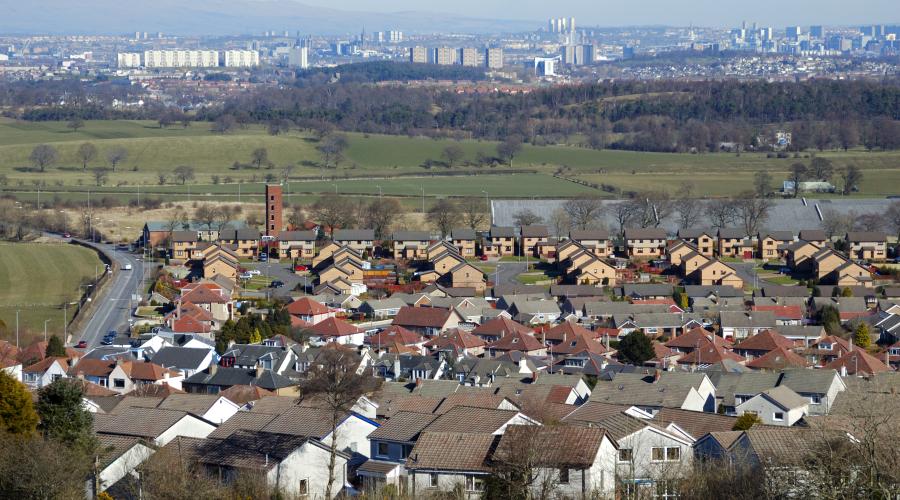
Planning for Great Places Newsletter
Our newsletter keeps you updated on new guidance, consultations, research, advice and good practice
Join the mailing list if you wish to be sent our newsletter.
We would welcome your feedback on the newsletter. To unsubscribe, or for any questions or comments, please email editor@nature.scot.
Planning for Great Places Newsletter - Issue 12 - November 2024
Welcome to our Planning for Great Places e-bulletin. This is your way of keeping up to date with guidance, consultations, research, and good practice related to development and nature. We would be glad to receive your feedback on the bulletin via editor@nature.scot
Grassland fungi mapping tool for Scotland
The UK is one of the European strongholds for Waxcaps and other grassland fungi, several of which are classed as threatened on the European Red List. They are characteristic of pastures and meadows, and come in a stunning variety of colours and shapes. The historical management of grasslands in the UK has meant we have some of the best habitat for these species of fungi. This is ancient unimproved grassland that has been nurtured by farmers for generations, keeping them short, undisturbed, unfertilised, nutrient-poor and well-drained.
To help protect these fungal assemblages we have created a mapping tool that identifies areas with the greatest diversity and the presence of threatened species. It is hoped that the map will allow developers and land managers to take account of these areas at an early stage in planning processes, so that they can remain under favourable management.
The mapping tool is available on our website page, and the mapping layers can be accessed and downloaded from Spatial Data.gov.scot.
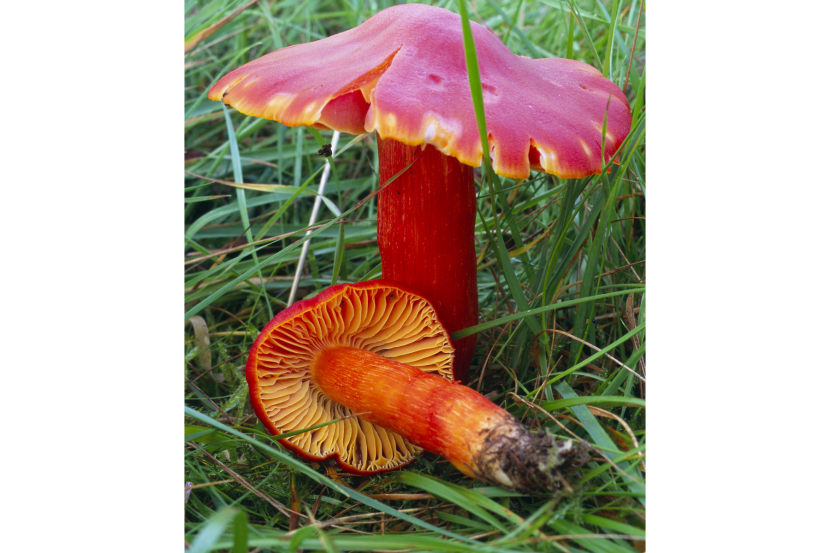
Pollintator map of Scotland
One of the objectives of Scotland’s Pollinator Strategy is to improve our understanding of pollinators and the service they provide. Key to this is a better understanding of the spatial distribution of resources available to pollinators at a landscape scale, to help identify where habitat improvement and restoration effort is best targeted to benefit pollinators.
To deliver this in an accessible way we have created PollMap. It pulls together data on the occurrence of a broad list of pollinator-friendly plants and pollinator species to score every habitat on Scotland’s land surface in terms of pollinator-friendliness. The accompanying storyboard explains this in more detail. The map provides planners, developers and others with a quick and easy way to identify, at Scotland or local authority scale, where there is most scope for improvement or extending habitat for pollinators.

Council leads the way with major peatland restoration project
Inverclyde Council is restoring a massive area of peatland on Duchal Moor, in a three-year project funded by NatureScot’s Peatland ACTION partnership. The project is supported by Glasgow and Clyde Valley Green Network's Clyde Peatlands initiative, which aims to increase the rate and scale of peatland restoration across the whole City Region in a bid to reduce carbon emissions.
The project secured £768,705 of Peatland Action funding to carry out the work and will restore 788 hectares of drained peatland. Work began in early 2024 and is due to be completed in 2026. It has contributed to the Council winning the COSLA Excellence Award for improving the environment and reducing its carbon emissions. The peatland restoration project, and the planting of 10,600 trees at Coves Local Nature Reserve (supported by the Nature Restoration Fund), won the Just Transition to a Net Zero Economy category of the prestigious award.
Inverclyde Council is one of the first local authorities in Scotland to carry out peatland restoration on this scale, with one of the largest projects undertaken so far. The project is a key part of the Council’s ambitious plans to reach net zero greenhouse gas emissions by 2045, in line with Scottish Government targets.
Peatland restoration offers multiple benefits besides reducing carbon emissions that contribute to a range of local authority priorities and targets, such as flood mitigation, increasing biodiversity, improving water quality, reducing wildfire risk, and boosting green jobs and opportunities for recreation and tourism.
Find out more about NatureScot Peatland ACTION at www.nature.scot/peatlandaction.
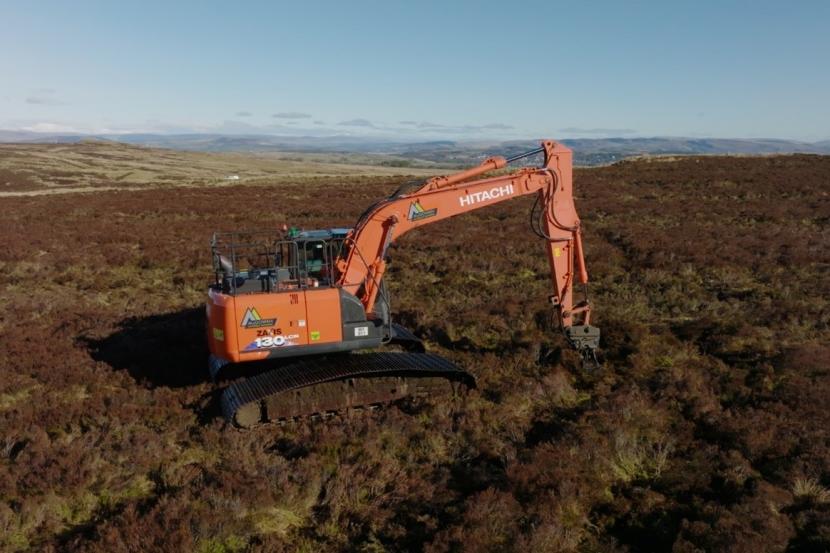
CIEEM Guidelines for Ecological Impact Assessment
The Chartered Institute of Ecology and Environmental Management (CIEEM) has updated its Guidelines for Ecological Impact Assessment in the UK and Ireland, which provides practical advice for all professionals involved with ecological evaluation and assessment for proposed developments in terrestrial, freshwater, marine and coastal environments.
The new Version 1.3 has been redesigned to improve accessibility and includes amendments to reflect recent changes to the national planning framework. It also includes more guidance on how peatland and soils should be considered in Ecological Impact Assessment.
Review of NatureScot peatland guidance
Through our involvement with the Peatland Expert Advisory Group (PEAG), we have set up a subgroup tasked with reviewing and updating aspects of our guidance Advising on peatland, carbon-rich soils and priority peatland habitats in development management. This guidance is aimed at NatureScot staff, as well as developers and consultants.
The Subgroup is composed of NatureScot, SEPA, FLS, HES and representatives from developers, consultants, contractors, and an environmental NGO. It is now finalising elements of the review, with the end goal of a ‘win-win’ for energy generation and care of peatland habitats. Further consideration is needed on the ratio for offsetting impacts to peatland from development, and the connections of this work with NatureScot’s commission to develop a Scottish biodiversity metric for the planning system.
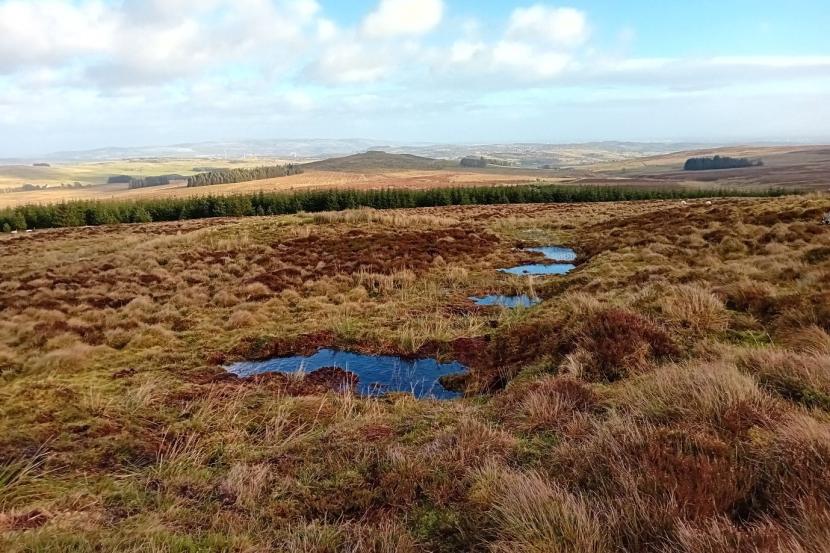
A biodviersity metric for Scotland's planning system
As highlighted in our previous Planning for Great Places Newsletter (Issue 11, May 2024), NatureScot has been commissioned by the Scottish Government to develop a biodiversity metric for Scotland’s planning system. This is specifically to support delivery of National Planning Framework 4 (NPF4) Policy 3b, with a focus on adapting the existing English statutory biodiversity metric to produce a tool that is suitable for use in Scotland.
In September we published a Scottish biodiversity metric page on our website. It provides an outline of the metric work, and is where we will publish further updates and an early indication of the intended approach as the metric project progresses. A consultation on the key issues to be considered when developing the metric took place in spring 2024, and a summary of the issues identified is now available to view on the web page. This provides a useful overview of some of the main challenges that will need to be addressed in developing the metric. If you have any queries or further comments that could assist with the development the metric, please email PLANNINGRENEWABLES@nature.scot.
Onshore Wind: New guidance on assessing the effects of aviation lighting on our landscapes
We have published new Guidance on Aviation Lighting Impact Assessment, which has been prepared by the Scottish Government led Aviation Lighting Working Group. This guidance should now be adopted as industry standard good practice and replaces the previous NatureScot advice on turbine lighting which sat within NatureScot pre-application guidance for onshore wind farms.
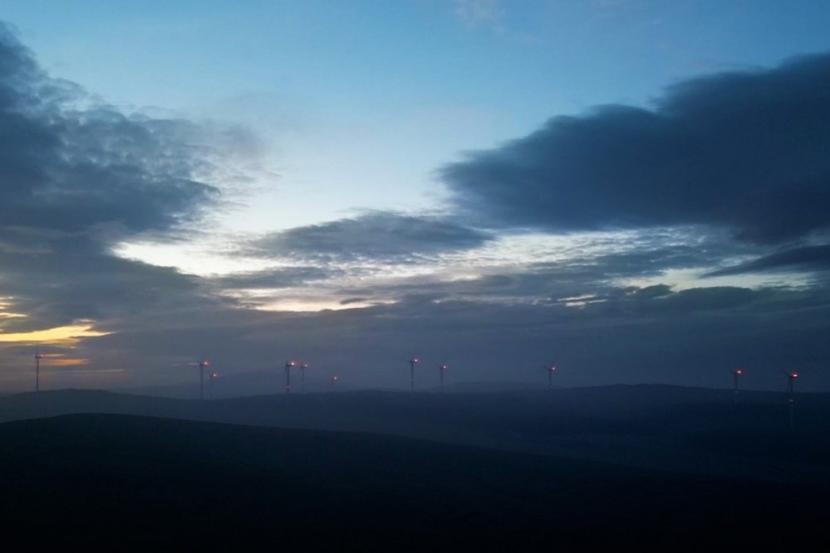
InformedDECISION launching early 2025
NatureScot is launching a new on-line platform InformedDECISION in early 2025, to improve our processes when consulted as a statutory planning consultee, and as a regulator when issuing consents for activities on Sites of Special Scientific Interest (SSSI). It will provide a faster and more consistent service to anyone needing advice or consent, by standardising the questions we ask and ensuring a smooth pathway to getting us the right information at the right time. The platform is built to Government Digital Standards so your interaction with it will feel much the same as other platforms you might be familiar with (e.g. passport applications).
We have been piloting the platform over the last 18 months in our Operations South area with several local authorities, Scottish Forestry, selected environmental consultancies, and applicants for SSSI Consents. Applications have taken approximately 10 minutes on average, and examples of the positive feedback we have had so far include “Usual familiar interface, clearly laid out and pretty straightforward”, “Clearly set out and follows a logical order. The forms are easy to use”, “It gave me a degree of comfort. This is much better than old fashioned consultation, giving me continuous feedback and enabling further comment”.
The platform is in the final stages of development before going live. This includes creating a facility to allow our case officers to select what documents they want to see directly from local authority planning portals, which should shorten the application time for planning authorities. Over the coming months, we will also be engaging with relevant organisations to raise awareness of our move to this new platform, and running training sessions (amongst a range of learning materials) in the new year. If you have any queries please get in touch via informed@planning.nature.scot
Marine energy planning in Scotland
Over the last 20 years, two thirds of Scotland’s breeding seabird species have declined. Adding to this, the advent of offshore wind brings concerns about potential impacts to seabirds from either collision or displacement. The slower emergence of tidal stream energy generation also brings with it risks around potential collision impacts as well as disturbance to fish, birds, and marine mammals.
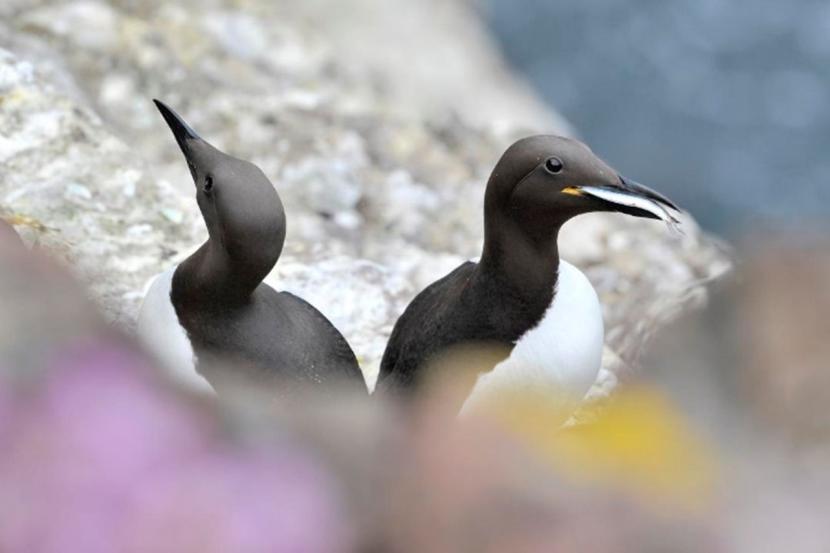
Our knowledge of the marine environment is limited, and the costs of surveys are a magnitude greater than terrestrial surveys with added complexities. The ability to build out in these extreme conditions requires wide project (Rochdale) design envelopes at the application stage, which are only refined after consent. This can require a multitude of scenarios to identify the worst-case scenario under EIA. Marine spatial squeeze is increasing, there are now many more competing users and uses for our marine areas. In Scotland, whilst we have achieved over 30% of nature conservation protected areas, there is still a long way to go in implementing conservation management measures.
Innovative and strategic research has helped to fill some of the knowledge gaps – for example, designing camera systems to understand interactions between predator and prey species, miniaturising tags to attach to birds, fish etc. to track their movements and ingenious engineering designs for floating wind turbines.
We have an opportunity to be bold in securing solutions for biodiversity and meet net zero targets. The Sectoral Marine Plan for Offshore Wind, now under review, is likely to become one of the first plans in Scotland where plan-level compensation will be necessary. The first applications requiring project compensation under the Habitats Regulations are currently being determined by Marine Directorate.
Offshore wind: seabird monitoring and impact assessment guidance
In early October, our Marine Energy team along with the Scottish Offshore Wind Directorate ScotMer team held a joint workshop with invited consultants, academics and developers to discuss the emerging evidence regarding the displacement of seabirds by offshore wind farms. Over 80 people attended and heard a series of talks on recently published papers about the interaction of seabirds with windfarms.
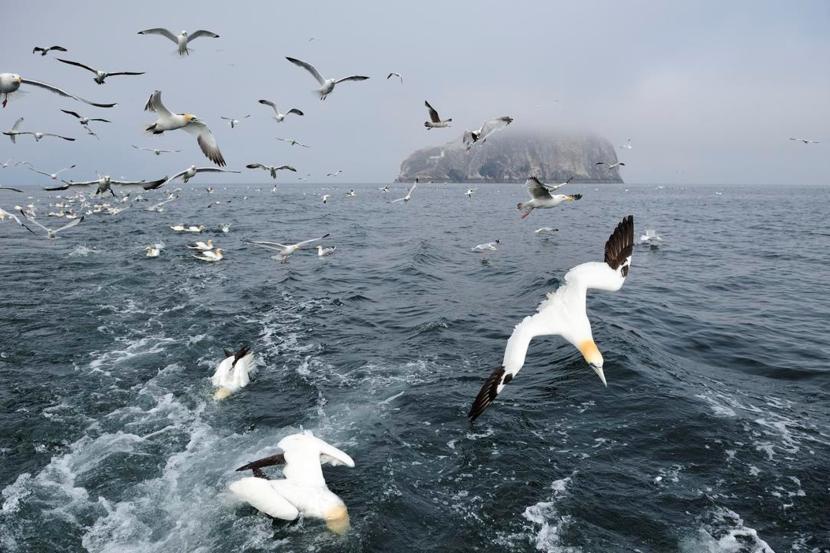
We heard evidence on guillemot behaviour at the Beatrice windfarm in the Moray Firth, a long-term study considering cumulative effects on operating windfarms in the German North Sea and how that is influencing the planning for new offshore windfarms. There were also presentations on the different models that are used in EIA to help calculate predicted mortality rates of displacement.
The purpose of the workshop was to share the emerging evidence and how it might change existing guidance, and to consider any further research requirements. The next step is to finalise work on the materials gathered at the workshop, and to decide emerging actions, key leads and timescales. The workshop was welcomed by all the participants as a transparent approach to closing the loop between scientific studies and how it can inform/influence policy and guidance. In light of the workshop conclusions we will be reviewing and updating our existing guidance notes in respect of ornithological impact assessment. If there are any aspects you wish us to take into consideration when updating the guidance notes, please email marineenergy@nature.scot.
Get in touch, subscribe, or unsubscribe
If you or a colleague would like to subscribe/unsubscribe to this e-bulletin, or have any questions or comments please drop us a line at editor@nature.scot.
Planning for Great Places Newsletter - Issue 11 - May 2024
Welcome to our Planning for Great Places e-bulletin. This is your way of keeping up to date with guidance, consultations, research, and good practice related to development and nature. We would be glad to receive your feedback on the bulletin via editor@nature.scot
Biodiversity Metric for Scotland's planning system
The Scottish Government has commissioned NatureScot to develop a biodiversity metric in support of NPF4 Policy 3(b). This policy requires all national, major and EIA development to include “significant biodiversity enhancements” that leave nature in a “demonstrably better state than without intervention”. How this is demonstrated in practice has been left to Planning Authorities and applicants to decide. The statutory biodiversity metric developed for England’s planning system is one possible approach, but earlier research identified that it requires refinement to better reflect the Scottish context. It is this refinement of England’s metric that we have been tasked with.
In early April we issued a consultation on the key issues identified for developing a Scottish metric, inviting comments by 10th May. The consultation paper provides more background to this work and how it will be taken forward, and discusses the issues identified without offering solutions at this stage. This is the start of a process intended to involve a range of stakeholders and learn from their experience of applying metrics to measure biodiversity enhancement that will be delivered by development. If you wish to be added to the list of stakeholders interested in this work, please email PLANNINGRENEWABLES@nature.scot.

Nature Network Toolbox
Following the Framework for Nature Networks in Scotland, we have begun developing the Nature Networks Toolbox.
The Nature Networks Toolbox will be a ‘live’ resource for local authorities, partnerships, organisations, and groups, to facilitate the design and implementation of Nature Networks at the local and regional level. This will allow for efficiencies in designing and implementing Nature Networks and support strong alignment in approaches across Scotland. The Toolbox will evolve over time and its contents decided through working with users to ensure it provides the information that can lead to practical implementation activities.
Basic elements may include;
- Learning from existing and proposed projects for Nature Networks e.g. through case studies and best practice
- Guidance and signposting to resources
- Connectivity and opportunity mapping tools
- Information on public and private funding, finance and investment.
Some of the first sections on the toolbox cover Sector advice, Case studies, Tools and Data, Funding and more. Some key initial guidance on the toolbox is the Planning Authorities and Nature Networks, which aims to help planning authorities apply the requirements of NPF4 for Nature Networks into Local Development Plans.
The toolbox will continue to be added to over time as guidance and resources become available. Do take a look!
Guidance on Establishing and Managing Local Nature Conservation Site Systems in Scotland
Working with partners from The Scottish Geology Trust, Scottish Wildlife Trust, and local authorities, we have published updated Guidance on Establishing and Managing Local Nature Conservation Site Systems in Scotland as part of our Professional Advice on Local Designations. The updated guidance demonstrates how LNCS can contribute to local nature networks and is part of Sector advice for Local authorities and planning authorities in the new the Nature Networks toolbox.
The guidance is aimed at local authorities, members of LNCS partnerships, Local Biodiversity Action Plan partners, environmental Non-Governmental Organisations and other biodiversity and geodiversity conservation bodies, developers, planners, and ecologists. It recognises that 27 of Scotland’s Planning Authorities already manage LNCS systems, with over 3,400 sites designated, and it includes several examples of site selection methodologies.
It updates the previous guidance from 2006, confirming that the purpose of Local Nature Conservation Sites (LNCS) is to safeguard biodiversity and geodiversity of at least local importance, primarily through Local Development Plans, and that all LNCS should meet the general criteria set out in the guidance. The guidance sets LNCS within the current policy context of nature networks, spatial planning, and the nature crisis and climate emergency.
It highlights the need to map LNCS in Local Development Plans and implement policies to protect them from harmful development and other infrastructure. The guidance encourages ongoing review of LNCS to ensure that they remain fit for purpose, and the identification of new sites meeting the selection criteria. It aims to promote the good management of LNCS to retain their features of interest and to enhance sites where possible.
Peatland Expert Advisory Group
The Peatland Expert Advisory Group was set up to help deliver peatland related elements of the onshore wind sector deal. Through our involvement with the group, we have set up a subgroup tasked with reviewing and updating aspects of our guidance Advising on peatland, carbon-rich-soils and priority peatland habitats in development-management. This guidance is for NatureScot staff, as well as developers and consultants.
The subgroup is composed of NatureScot, SEPA, FLS, HES and representatives from developers, consultants, contractors, and an environmental NGO. It will co-produce elements of the guidance relevant to these stakeholders, with the end goal of a ‘win-win’ for energy generation and care of peatland habitats. The subgroup is also working towards shared definitions for peatland restoration, alignment on peat reuse and waste, assessing impacts, and compensation. Finally, we plan to develop a framework for the Scottish Peatland Standard, a coherent guidance package for mitigating impacts on peatland and providing biodiversity enhancement.
Potential surge in PDR applications for peatland restoration over the summer
Planning authorities may see a surge in Permitted Development Rights (PDR) applications this summer, as a result of a change to the way we are administering Peatland ACTION funding. Instead of a rolling programme of funding, there is now a deadline of 31 May 2024 for applications for the current financial year 2024-2025. The applications will be scored competitively against a set of criteria around cost, value for money, financial contribution and restoration size. Successful applicants will be announced by the end of June.
It is therefore possible that a larger number of applicants than usual will need to submit PDR applications at a similar time, once they have been notified that their application has been successful.
More information about the new process for applying for Peatland ACTION funding is available on the Peatland ACTION web pages.
Inverclyde Council uses peatland restoration to tackle climate change and reduce flood risks
As part of its plans to hit its net zero target by 2045 Inverclyde Council is working with Peatland ACTION through the Clyde Valley Green Network to restore over 800ha of peatlands on its land at Duchal Moor. The work at the site is taking place over three phases from 2023 to 2026.
The Council is one of the first in Scotland to take on such large-scale peatland restoration. As well as delivering significant climate savings it sees the work as contributing to its plans to reduce flood risk in the area, which is near the top of the River Calder catchment. By slowing the flow of water off the site the restoration work should help prevent flash flooding of built-up areas further downstream.
You can watch a case study film of the project on the our Peatland ACTION YouTube playlist.

If you’d like to keep up to date with all aspects of Peatland ACTION, you can follow across your social media channels LinkedIn| Facebook | X, formerly Twitter. You’ll also now find a weekly feature covering peatland restoration on the Scotland’s Nature blog.
Get in touch, subscribe, or unsubscribe
If you or a colleague would like to subscribe/unsubscribe to this e-bulletin, or have any questions or comments please drop us a line at editor@nature.scot
Planning for Great Places Newsletter - Issue 10 - October 2023
Welcome to our tenth Planning for Great Places e-bulletin. This is your way of keeping up to date with guidance, consultations, research, and good practice related to development and nature. We would be glad to receive your feedback on the bulletin via editor@nature.scot
Nature Networks and 30 by 30
Since our last update in the previous Newsletter, we have been busy preparing draft frameworks for Nature Networks and 30 by 30. Consultation on the frameworks is now underway as part of the SBS consultation.
The frameworks aim to catalyse the urgent and transformative action needed across Scotland to implement Nature Networks and achieve the 30 by 30 target. They were developed through a co-design process involving 130 organisations and groups from across Scotland, and outline the basic principles that associated action and delivery, at all levels, should be founded upon.
In June, the Scottish Government provided Local Authorities with capital funding of £5 million for Nature Networks. The funds, which are part of the Nature Restoration Fund, are to be spent this financial year. Guidance and supporting information has been developed to support Local Authorities in their allocation of this money.
We are in the process of establishing a team of operational staff within NatureScot who will work with our Local Authority colleagues to share information, support the process of identifying Networks, and provide feedback at the officer level. We are also looking to work with Local Authorities, amongst others, to make clear the relationship between Nature Networks and other relevant policies e.g. positive effects for biodiversity.
Stay up to date on Nature Networks and 30 by 30 by visiting our web pages. You can also contact our team at naturenetworks@nature.scot or 30x30@nature.scot
Hydroelectric Development Planning Tool
Scotland is internationally important for mosses and liverworts (bryophytes) that enjoy the rare oceanic climate of western Scotland. The distribution and occurrence of these bryophytes is therefore a key factor when considering the siting and design of hydroelectric development. Our Hydroelectric development planning tool identifies the most important watercourses for bryophytes in Scotland, so that developers can site and design hydro schemes that avoid harming the rarest and most vulnerable species.
The tool was updated in May following a review of the scoring system for bryophyte species. Some minor changes to data within the tool were required to reflect new knowledge regarding the status of some species, but overall the review concluded that the tool continues to provide accurate information to help developers explore opportunities for hydroelectric development.
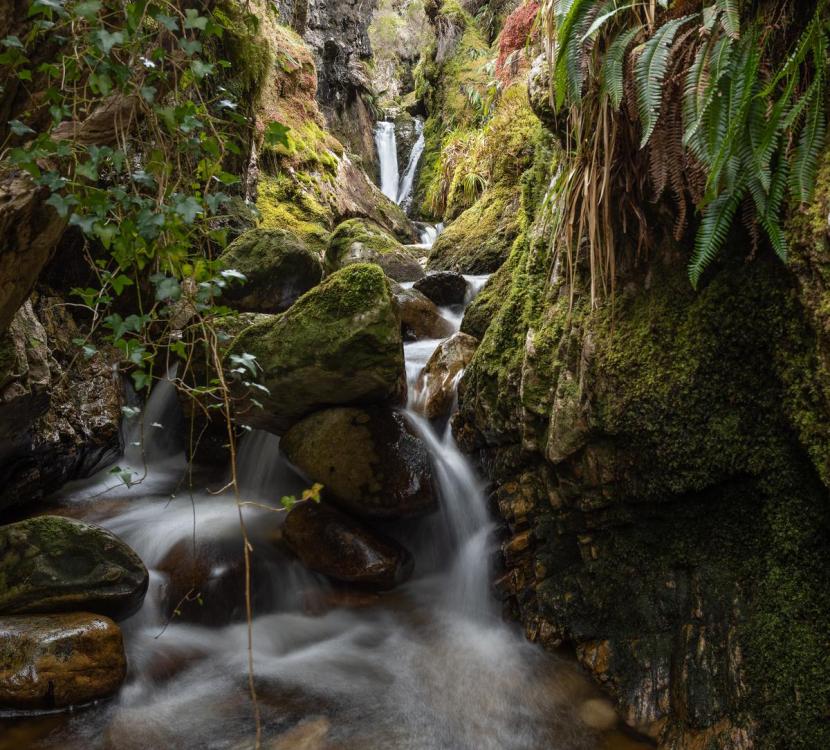
Beinn Eighe NNR gorge on Allt na h-Airighe rich in bryophyte.
Celebrating Park Life
The latest meeting of the Park Managers Forum, run by the urban greenspace charity greenspace scotland, was held on Midsummer’s Day in Falkirk. The theme was ‘nature restoration in urban greenspace’. NatureScot provided funding to enable greenspace scotland and Falkirk Council to bring together staff from 14 councils, with experience in a range of greenspace and planning specialisms, to consider challenges such as naturalising amenity grass and promoting nature restoration in a public park setting. Read more about it in this article on the NatureScot Pollinator blog
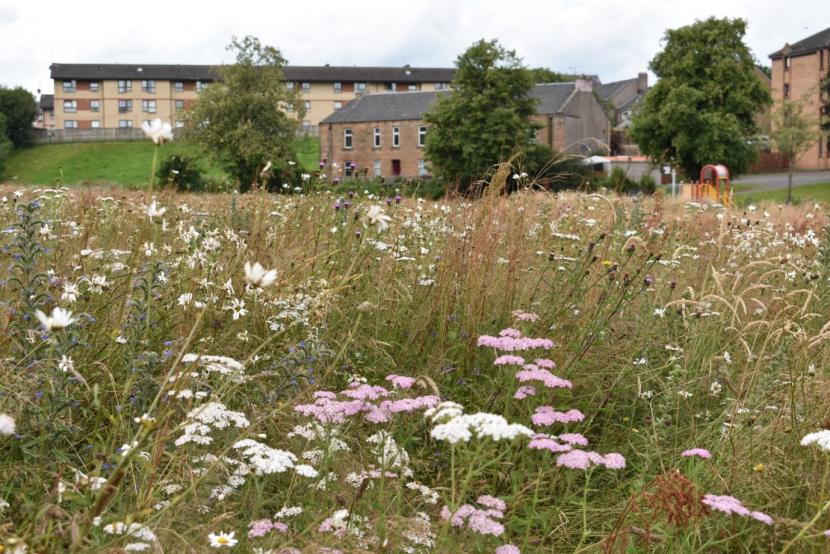
NPF4 Policy 3 Biodiversity – NatureScot to develop a Scottish metric
Scottish Government have recently announced that they are in the process of commissioning NatureScot to develop an adapted biodiversity metric for application within Scotland’s planning system. This will be particularly relevant to NPF4 policy 3(b).
In developing this metric we will draw on the recommendations set out in the SRUC report on approaches to measuring biodiversity in Scotland, and its analysis of the metric developed by Defra for England. Further details on timescales and engagement with stakeholders will be provided in due course.
Developing with Nature – new guidance in support of NPF4
Alongside the release of NPF4 in February 2023, NatureScot published a final version of its Developing with Nature guidance in support of biodiversity policy 3(c). This policy applies to most local development (exclusions include householder applications and those subject to EIA), and requires ‘appropriate measures’ that conserve, restore and enhance biodiversity to be delivered as part of the development. Developing with Nature provides applicants and planners with advice on what these appropriate measures are, and how best to select and deliver these.
Relatively few local developments will engage ecological expertise, so the Guidance sets out a straightforward approach and simple set of measures for enhancing biodiversity. These range in complexity from providing nest and roost sites for bees, bats and birds, through planting a meadow or orchard, to constructing a green wall or living roof. For each of the 24 measures the Guidance describes what it is and the nature benefits it provides, the site requirements and future management needed if it is to be successful, other biodiversity measures it complements, and web links to detailed design and management advice.
The intention is to demonstrate that any development can do something positive for nature, if opportunities are considered from an early stage. This should include not just the garden and greenspace elements of the development, but also the buildings and structures to be built, the borders and boundaries partitioning the site, and the management of rain and surface water.
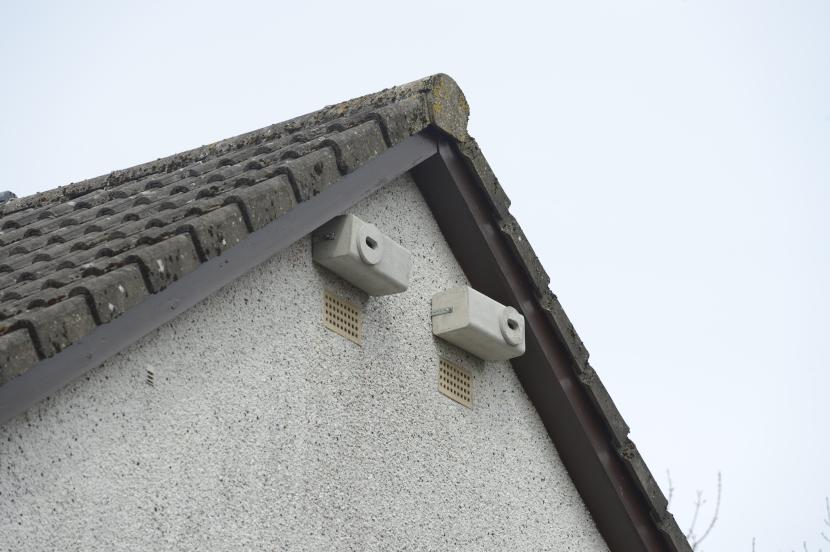
Externally mounted swift boxes.
Pre-application guidance for onshore wind farms
We have updated our pre-application guidance for onshore wind farms. The most significant changes are:
- alignment with National Planning Framework 4 (NPF4) policy, and inclusion of advice on the requirement to enhance biodiversity;
- an update to our peatland advice, including more advice on restoration;
- an update to our advice on turbine lighting (at Annex 1), including fuller information on potential mitigation options.
And some more minor changes:
- fuller landscape advice and guidance links;
- updated habitat survey advice;
- new short section on soils and geomorphology;
- link to our new mountain hare species advice note;
- updated bat advice, emphasising the benefit of feathering compared with normal idling to reduce collision risk, and what to do given the Ecobat tool is currently unavailable;
- some additional advice on wind farm variation applications and repowering.
Landscape scale natural capital tool
NatureScot is leading on the development of an innovative new tool that will facilitate decision makers to take a natural capital approach for managing land at the landscape scale in Scotland. A natural capital approach is when the full range of benefits that we receive from nature are taken into consideration within the decision-making process. Adopting a natural capital approach enables us to understand the role of our natural environment, alongside its intrinsic value, as an asset that underpins both our economy and society.
Nature provides a whole host of benefits that we are dependent on, known as ecosystem services, that are often overlooked in land management decision making. In order for these benefits to be included within the decision making process, we need the methodologies and tools to quantify them. By mapping and modelling how certain land use changes might impact the ecosystem services they provide, you can identify the scenarios that provide the most benefits for both people and nature.
The tool will be the first of its kind in Scotland and is being developed in collaboration with Liverpool John Moores University. The 'bones' of the tool will based on EcoServR, an existing tool in the coding language R for mapping natural capital assets and ecosystem services. The functionality of the tool, the ecosystem services that are measured, and the end product will be bespoke for Scotland and developed in line with the following key criteria:
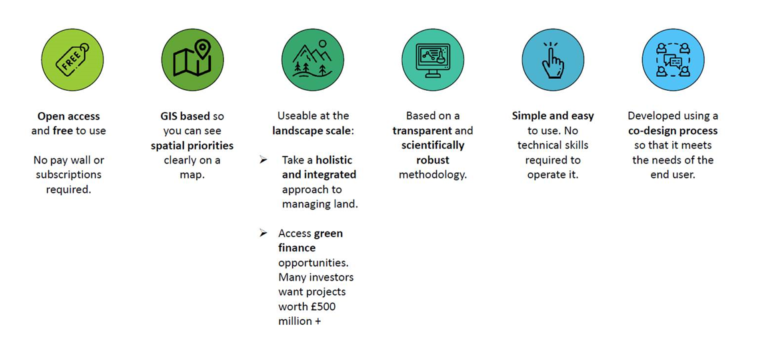
Six icons -
1. Open access and free to use. No pay wall or subscriptions required.
2. GIS based so you can see spatial priorities clearly on a map.
3. Useable at the landscape scale:
- Take a holistic and integrated approach to managing land.
- Access green finance opportunities. Many investors want projects worth £500 million+.
4. Based on a transparent and scientifically robust methodology.
5. Simple and easy to use. No technical skills required to operate it.
6. Developed using a co-design process so that it meets the needs of the end user.
A co-design group has been formed of 50+ different individuals from across a range of organisations including public bodies, eNGOs, local authorities, landscape scale partnerships, natural capital consultants, research institutions and green finance organisations. A series of workshops are running from December 2022 to March 2024, where the co-design group will help shape the development of the tool and test a prototype. The tool will also be piloted by landscape scale partnership groups in November 2023. More info can be found at our website: Developing a Landscape Scale Natural Capital Tool for Scotland, or contact Donya Davidson, Natural Capital Manager at NatureScot:
Advising on peatland, carbon-rich soils and priority peatland habitats in development management
We have recently issued a revised version of our guidance note on Advising on peatland, carbon-rich soils and priority peatland habitats in development management. The guidance is for use by NatureScot staff, developers and consultants. A key focus is on helping to ensure that development is designed and constructed to follow the mitigation hierarchy set out in NPF4, and that biodiversity enhancement is delivered through peatland restoration.
The revised guidance provides clearer advice on how we identify priority peatland and assess whether a development will result in impacts which raise issues of national interest. It also provides advice on the key information we require from developers to be able to advise regarding potential impacts on peatland.
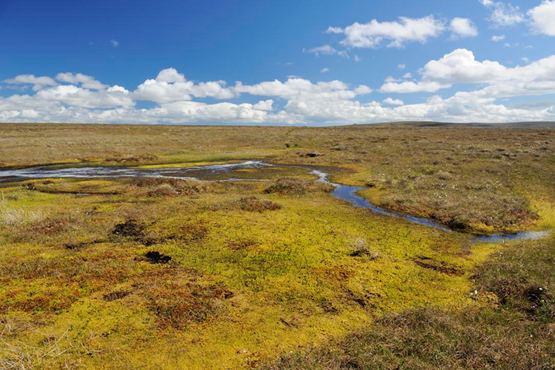
Permitted development rights and peatland restoration guidance is available online
The Scottish Government’s Infrastructure Investment Plan aims to put 250,000 hectares of degraded peatland on the road to recovery by 2030. In their Vision for Scotland, Ministers announced an interim commitment to deliver up to 110,000 hectares of restored peatland by 2026. This included a target of 10,700 hectares in 2023-24, an increase of 40% on 2022-23.
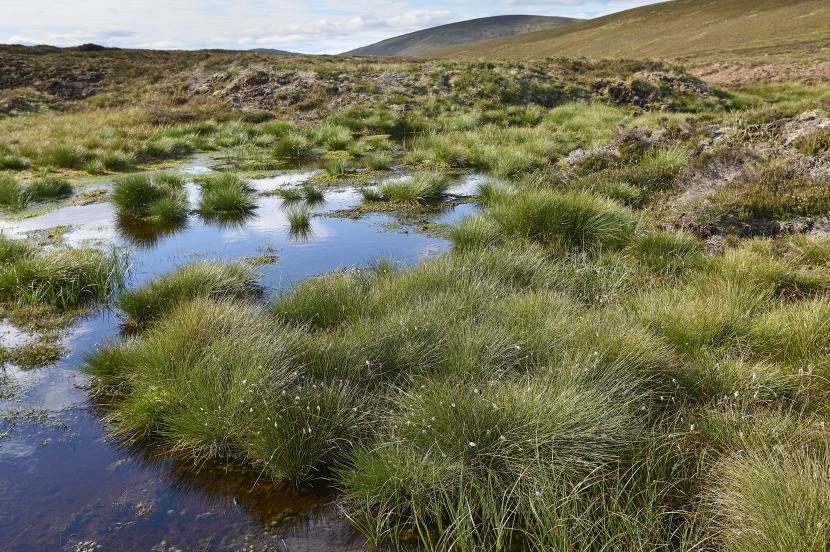
New technical compendium of peatland restoration techniques
Scotland’s Peatland ACTION programme has published a vital new source of information and guidance on peatland restoration as it marks its first decade. The technical compendium of peatland restoration techniques is built on the shared experience of the Peatland ACTION Programme, since its inception in 2012, in applying peatland restoration techniques and assessing their outcomes.
It provides an overview of the procedural and technical requirements for peatland restoration in Scotland, alongside an introduction to the types of restoration interventions that have been applied to date by Peatland ACTION.
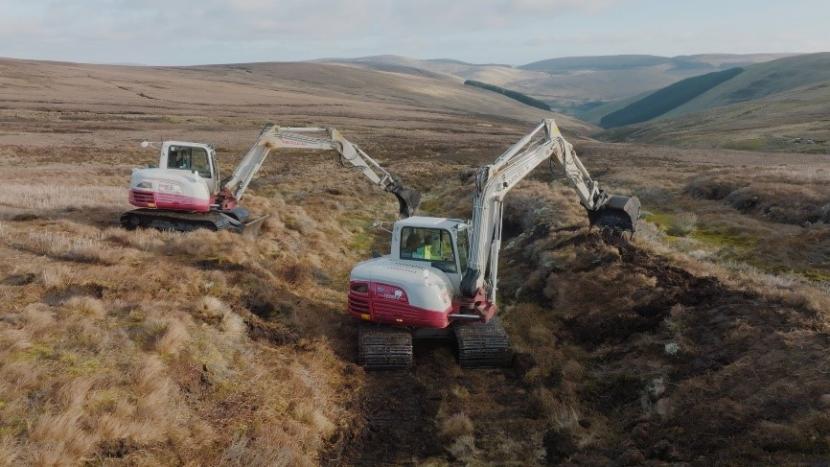
Serving as a best practice guide, it also includes novel techniques developed by the Peatland ACTION partnership, such as wave damming and zippering and new generation forest-to-bog restoration options. It includes information on the requirements for peatland restoration in Scotland and the potential means to achieve success, and paves the way towards a UK-wide set of principles.
A new online hub for the Peatland ACTION Technical Compendium is available on the NatureScot website. Recently updated guidance on undertaking work during the bird breeding season to give a better understanding of the responsibilities and requirements during times of bird breeding activity is also available on the NatureScot Peatland Restoration and Breeding Birds publication page.
New mapping portal helps visualise peatland data
Peatland ACTION has recently launched an interactive peatland restoration data mapping tool for Scotland, offering access to valuable information and analysis. Users can view completed peatland restoration projects across the country, as well as feasibility studies and details of peat depths and condition surveys. Future development of the portal will also see hydrological monitoring results such as water table depths included in the available data.
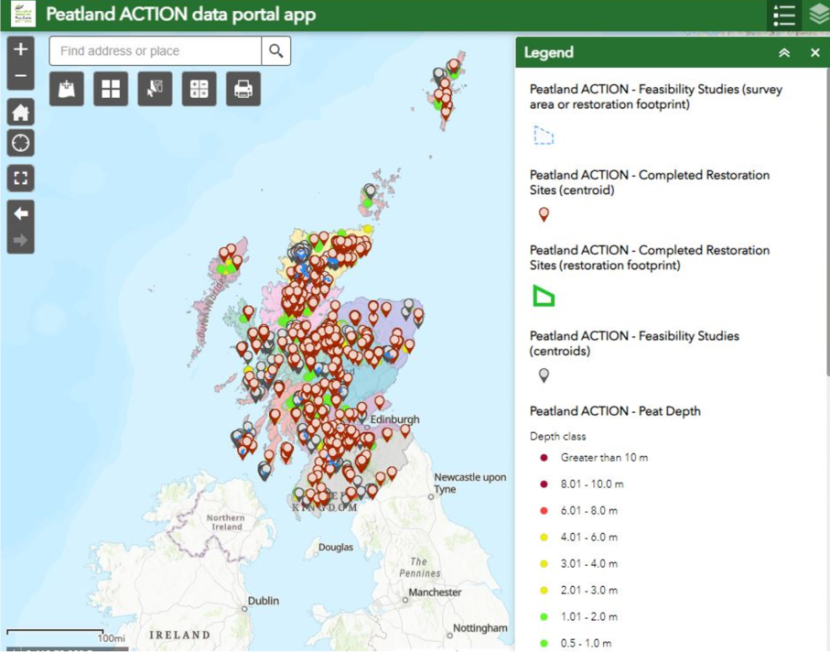
Visit the Peatland ACTION data mapping portal web page to find out more, including tips on how to use the tool.
When producing maps or other visuals please acknowledge use of data with the following attribution statement: This [map / graphic etc.] contains Peatland ACTION data licenced under the Open Government Licence v3.0
Peat Landslide Risk Protocols – online training
A training session will be held in September to provide a refresher for existing users and an introduction for new users of the Peat Landslide Risk Protocols. These are freely available and downloadable tools for evaluating potential landslide risks associated with restoration groundworks in peatlands. Two tools are available, one addressing restoration works in blanket bogs, and one that considers raised bogs. The sessions will provide a brief overview of peat instability, an explanation of why this is relevant to peatland restoration works, and then a detailed walk through of the two landslide risk protocols. The session will close with a question and answer session to allow existing and new users an opportunity to clarify data requirements and usage scenarios. For more information on how to sign up, contact peatlandactiontraining@nature.scot
Series of Peatland ACTION case study films showcase peatland restoration
A new suite of films have been made to promote the Peatland ACTION project and encourage landowners and contractors to get involved in peatland restoration. The films feature three case studies from different parts of the country where applicants, their agents and contractors talk about their experiences of peatland restoration and the benefits restoration bring to the area. As well as a longer 14-minutes film, there are also three-minute case study films, and two one-minute films focusing on the landowners’ and contractors’ perspectives. Watch the new series of films on the NatureScot Peatland ACTION case study playlist on YouTube. The most recent case studies featuring Moss of Cree in Dumfries and Galloway; Lochrosque Estate in the Highlands; and Wemyss and March Estate in the Borders – are also available as written versions on the NatureScot Peatland ACTION webpage, alongside many more.
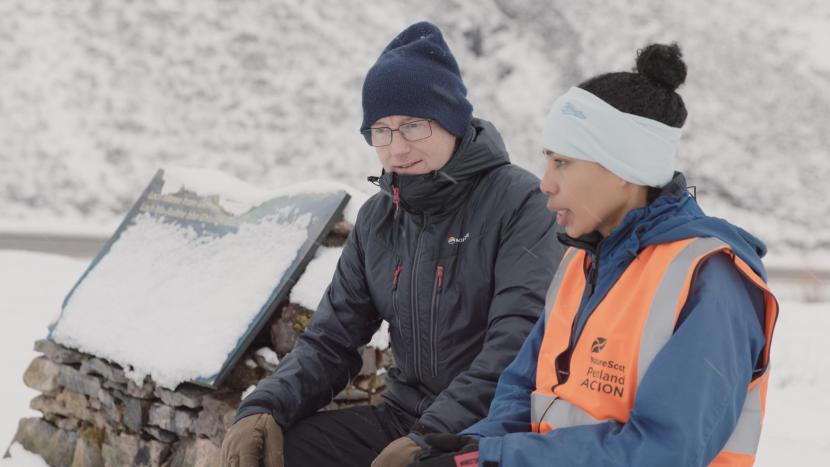
Change to NatureScot Operations email addresses
From 4th September NatureScot Operations will be using these new group email addresses to reflect recent boundary changes we have made to our patches and to help us manage your enquiries more effectively.
North@Nature.scot
CentralHighland@Nature.scot
West@Nature.scot
WestCentral@nature.scot
South@Nature.scot
Please see our NatureScot Offices web page for further contact details and to check where to direct your enquiry. We look forward to hearing from you.
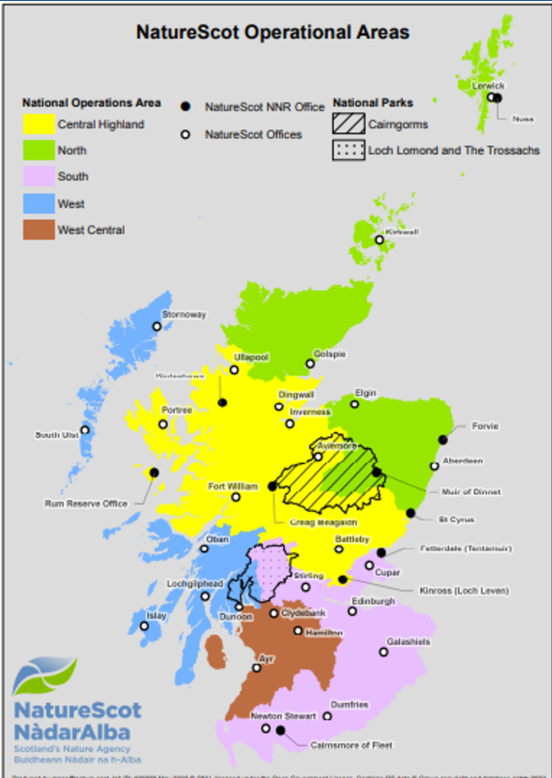
Showing the 5 Operational Areas.
Get in touch, subscribe, or unsubscribe
If you or a colleague would like to subscribe/unsubscribe to this e-bulletin, or have any questions or comments please drop us a line at editor@nature.scot
Planning for Great Places Newsletter - Issue 9 - October 2022
Welcome to our ninth Planning for Great Places e-bulletin. This is your way of keeping up to date with guidance, consultations, research, and good practice related to development and nature. We would be glad to receive your feedback on the bulletin via editor@nature.scot
Guidance for Peatland Restoration and the Historic Environment in Scotland
NatureScot have supported the development of new guidance from The Association of Local Government Archaeological Officers (ALGAO) in partnership with a range of Peatland ACTION delivery partners across Scotland. Written by Bruce Mann for ALGAO Scotland, in consultation with colleagues across the UK, the ALGAO Peatland Restoration and the Historic Environment Guidance Note sets out an informed procedure to secure the protection of heritage and historic environment features within peatland restoration projects. It seeks to ensure that applications submitted to local authorities meet the required standards under Permitted Development Rights in relation to archaeology and the historic environment, and for the process of planning authority approval in relation to these matters to be as streamlined as possible.
Peatlands have great historic environment significance due to the nature of the archaeological resource they may contain and the unique preservation qualities of the peat. For millennia, peatland areas have been exploited by humans for settlement, agriculture, industry, as route-ways and communication networks, and as “special” places for interring the dead and other ritual activities. Peatlands also provide an invaluable and irreplaceable record of past human activity, vegetation, climate, and landscape change.
New bird breeding guidance and a technical compendium for peatland restoration coming soon
NatureScot’s Peatland ACTION team are preparing two new pieces of guidance to support a range of work in peatland restoration. Firstly, new guidance on undertaking work during the bird breeding season will give peatland practitioners better understanding of their responsibilities and requirements during times of bird breeding activity. This season runs from March and August for the majority of moorland birds, but can extend into September or longer in certain locations for some species. For Schedule 1A birds (golden eagles, white-tailed eagles, hen harriers and red kites) projects need to demonstrate protection from harassment at any time, not just within the breeding season. Whilst the default approach of programming restoration work outside the main bird breeding season will remain, a key change will allow some works to proceed under specific circumstances. This will provide further flexibility on peatland restoration project delivery whilst maintaining legal requirements and minimising any potential conflict with Scotland’s wild birds breeding on these habitats.
Also in the pipeline is a technical compendium of peatland restoration techniques, built on the shared experience and learnings of the Peatland ACTION project since 2012. The compendium will include best practices across a wide range of peatland restoration techniques including drain blocking, bunding, gully and bare peat restoration and forest-to-bog techniques. The document will set out the aims of each restoration technique, the situations they work best and common issues and considerations for each technique. This new resource will also include an overview of the basic principles of the hydrology of peatlands to help explain the impacts, and aims, of the various restoration techniques. It also sets out the necessary considerations around licensing in relation to controlled activities in the water environment, drinking water catchments, permitted development rights, archaeological assessments, project health and safety, peat slide risks, grazing densities, muirburn activities and in relation to nature protected areas and species protection in the widest sense. The technical compendium will provide a useful tool to ensure consistency, quality, confidence, and best practice by designers and contractors working on peatland restoration projects.
Both new guidance resources will be available to view following publication on the Peatland Action page of our website.
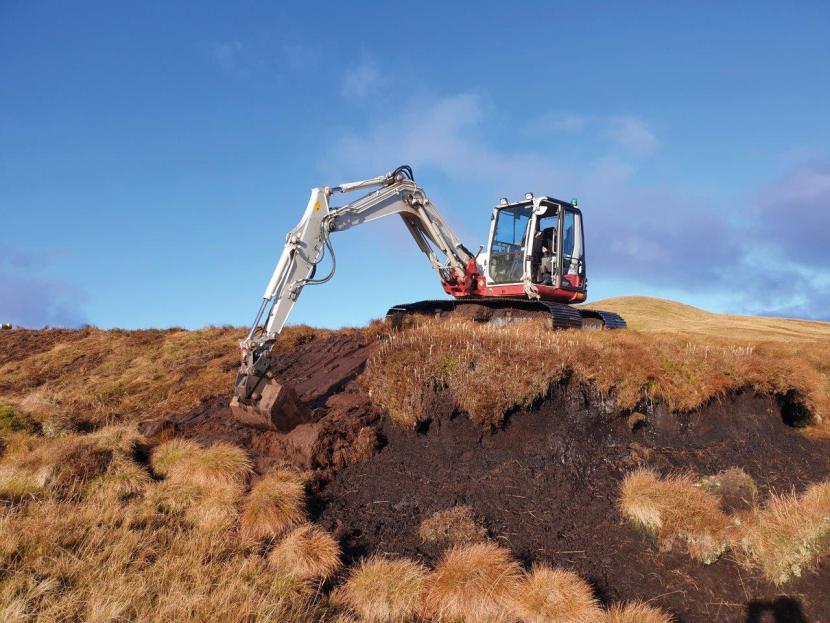
Towards a framework for Nature Networks
Over the summer we have been running a series of events to co-design a framework that will help local authorities in Scotland create new Nature Networks by 2030, a commitment of the 2021 Programme for Government and key element in delivering the Scottish Biodiversity Strategy. So far 18 different local authorities have taken part in virtual workshops, working collaboratively with over 90 different organisations to identify the challenges faced in creating Nature Networks.
The team in NatureScot are currently pulling together all the information from these workshops in preparation of the next set of workshops in October and November that will focus on finding solutions to the challenges faced. More information, including how to sign up for future events, can be found on our Nature Network themed workeshops page.
Development Framework for Hagshaw Energy Cluster
The Development Framework for the Hagshaw energy cluster has now been completed and is going through the formal process of adoption by East Ayrshire and South Lanarkshire Councils. The latest draft version is available on the project website, and we anticipate final adoption by December 2022.
It paves the way for a new approach to planning for wind energy, putting a Just Transition to net zero and investment in nature in and around the local communities at its heart. The project has demonstrated the benefit of collaboration between developers, agencies, communities and planning authorities, in identifying the priorities for investment of around £2.7m of community benefit funding each year.
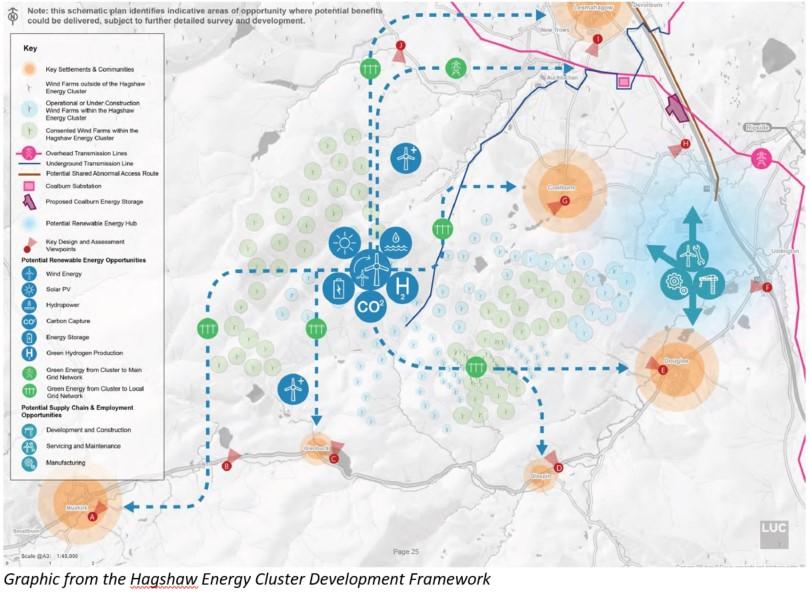
This schematic plan is described in the Development Framework for Hagshaw Energy Cluster section.
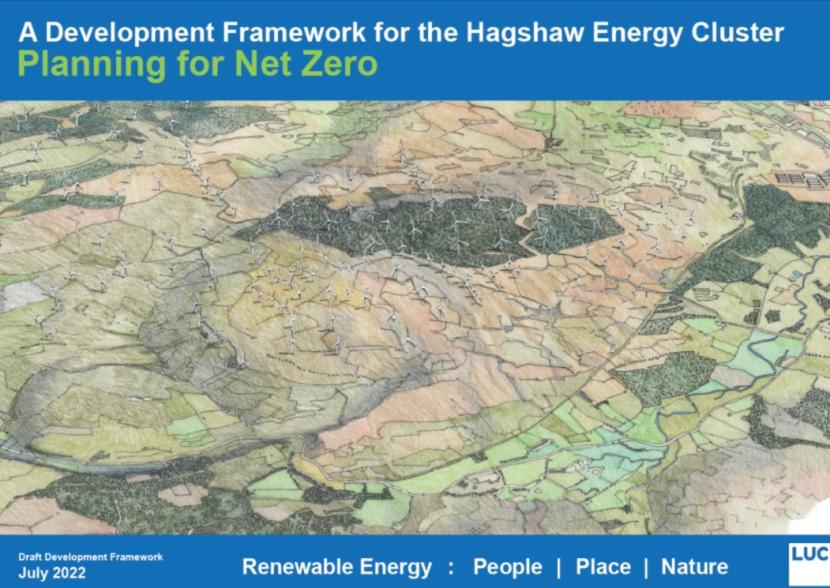
Front cover of the Development page document as published on the LUC website.
NatureScot are looking for locations to replicate the approach and working with partners to find resources to do this. If you are interested in taking a Development Framework forward, please contact brendan.turvey@nature.scot
Coastal Adaptation takes a step forward
The Scottish Government has committed £12m over the next four years for Coastal Change Adaptation. These capital funds are being made to coastal local authorities to support the development of Coastal Change Adaptation Plans (similar to Shoreline Management Plans including Adaptation) alongside on-the-ground resilience and adaptation actions, using Nature-based approaches wherever possible. Interim Guidance is being developed to support local authorities.
Updated disturbance distances in selected bird species – The MacArthur Green Review
NatureScot have now published an updated literature review of disturbance distances of selected bird species, alongside a guidance note detailing how to interpret the findings of the review. The review provides an update to the disturbance distances presented in Ruddock and Whitfield (2007) and provides disturbance distance information for a range of additional protected bird species that regularly feature in assessments and consultations on developments. It provides an account for each species summarising: quantitative and qualitative information on disturbance distances, likely sensitivity to disturbance for the species and suggested buffer zones for each species; and includes recommendations for buffer zones that will contribute to guidance and best practice for assessments and consultations on developments affecting these species. The report and associated guidance note now replaces the Ruddock and Whitfield review when providing casework advice on disturbance to birds.
Other updated guidance
We have also updated the following guidance documents:
- General pre-application and scoping advice for onshore wind farms, including new sections on repowering, section 36 variations and species survey shelf life.
- General pre-application and scoping-advice-for solar-farms, which replaces our previous guidance Natural heritage considerations for solar photovoltaic installations (November 2017)
Remember all our planning guidance can be found in the one place on our Planning and development: standing advice and guidance documents page, with further information and guidance on our planning service.
Get in touch, subscribe or unsubscribe
If you or a colleague would like to subscribe/unsubscribe to this e-bulletin, or have any questions or comments please drop us a line at editor@nature.scot

Planning for Great Places Newsletter - Issue 8 - December 2021
Planning for Great Places Newsletter - Issue 7 - March 2021
Planning for Great Places newsletter - Issue 6 - April 2020
Issue 5 July 2019 Highlights: New or updated guidance on planning for coastal change, bats and wind turbines, development construction and Landscape Character Assessment; new construction web page; pollinator event; and our checklist for how and when to consult NatureScot.
Issue 4 October 2018 Highlights: 'Planning for Great Places' new service statement (publication); service statement survey report teaser (results to be published in November); publication of our Planning Performance Framework annual report; Guidance note: Coastal Character Assessment; and an update on the important changes happening to the use of mitigation when undertaking HRAs.
Issue 3 November 2017 Highlights: Planning for Development - What service do we provide?; species advice notes for developers; new guidance notes on wind farms; NatureScot 'Position Statement on Marine Planning'; notes on the revised Scottish Marine Wildlife Watching Code; and the publication of two Wild Land Areas reports.
The UK is one of the European strongholds for Waxcaps and other grassland fungi, several of which are classed as threatened on the European Red List. They are characteristic of pastures and meadows, and come in a stunning variety of colours and shapes. The historical management of grasslands in the UK has meant we have some of the best habitat for these species of fungi. This is ancient unimproved grassland that has been nurtured by farmers for generations, keeping them short, undisturbed, unfertilised, nutrient-poor and well-drained.
To help protect these fungal assemblages we have created a mapping tool that identifies areas with the greatest diversity and the presence of threatened species. It is hoped that the map will allow developers and land managers to take account of these areas at an early stage in planning processes, so that they can remain under favourable management.
The mapping tool is available on our website page, and the mapping layers can be accessed and downloaded from Spatial Data.gov.scot.

Disclaimer: Scottish Natural Heritage (SNH) has changed its name to NatureScot as of the 24th August 2020.
At the time of publishing, this document may still refer to Scottish Natural Heritage (SNH) and include the original branding. It may also contain broken links to the old domain.
If you have any issues accessing this document please contact us via our feedback form.






